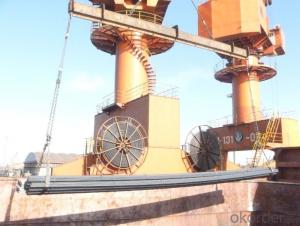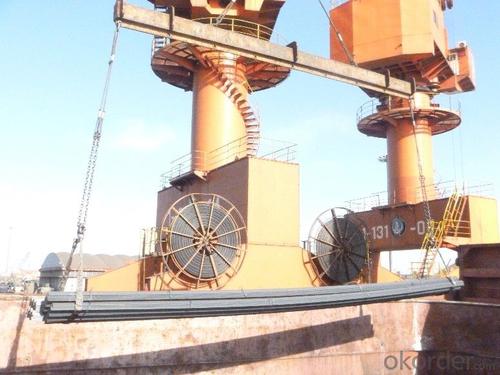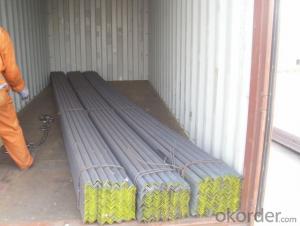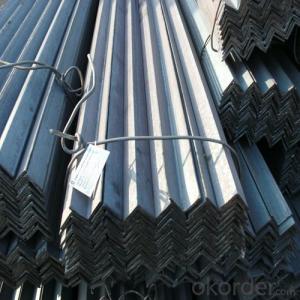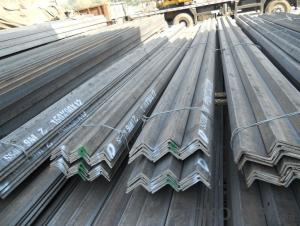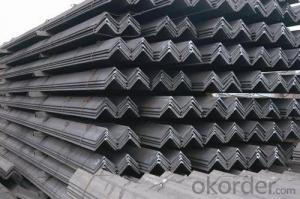High Quality Hot Rolled Steel Unequal Angle Equal Angle for Construction
- Loading Port:
- Tianjin
- Payment Terms:
- TT OR LC
- Min Order Qty:
- 25000 m.t.
- Supply Capability:
- 2000000 m.t./month
OKorder Service Pledge
OKorder Financial Service
You Might Also Like
Specification
Product Description:
OKorder is offering High Quality Hot Rolled Steel Unequal Angle Equal Angle for Construction at great prices with worldwide shipping. Our supplier is a world-class manufacturer of steel, with our products utilized the world over. OKorder annually supplies products to European, North American and Asian markets. We provide quotations within 24 hours of receiving an inquiry and guarantee competitive prices.
Product Applications:
High Quality Hot Rolled Steel Equal Angle Equal Angle for Construction are ideal for structural applications and are widely used in the construction of buildings and bridges, and the manufacturing, petrochemical, and transportation industries.
Product Advantages:
OKorder'sHigh Quality Hot Rolled Steel Unequal Angle Equal Angle for Construction are durable, strong, and resist corrosion. They are newly produeced by good materiales.
Main Product Features:
· Premium quality
· Prompt delivery & seaworthy packing (30 days after receiving deposit)
· Corrosion resistance
· Can be recycled and reused
· Mill test certification
· Professional Service
· Competitive pricing
Product Specifications:
Specifications ofHigh Quality Hot Rolled Steel Unequal Angle Equal Angle for Construction
1. Invoicing on theoretical weight or actual weight as customer request
2. Length: 6m, 9m, 12m as following table
3. Sizes
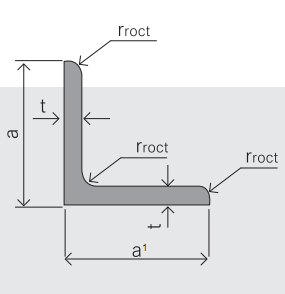
Sizes: 25mm-250mm | ||
a*t | ||
25*2.5-4.0 | 70*6.0-9.0 | 130*9.0-15 |
30*2.5-6.6 | 75*6.0-9.0 | 140*10-14 |
36*3.0-5.0 | 80*5.0-10 | 150*10-20 |
38*2.3-6.0 | 90*7.0-10 | 160*10-16 |
40*3.0-5.0 | 100*6.0-12 | 175*12-15 |
45*4.0-6.0 | 110*8.0-10 | 180*12-18 |
50*4.0-6.0 | 120*6.0-15 | 200*14-25 |
60*4.0-8.0 | 125*8.0-14 | 250*25 |
5. Payment terms:
1).100% irrevocable L/C at sight.
2).30% T/T prepaid and the balance against the copy of B/L.
3).30% T/T prepaid and the balance against L/C
6.Material details:
Alloy No | Grade | Element (%) | |||||
C | Mn | S | P | Si | |||
Q235 | B | 0.12—0.20 | 0.3—0.7 | ≤0.045 | ≤0.045 | ≤0.3 | |
Alloy No | Grade | Yielding strength point( Mpa) | |||||
Thickness (mm) | |||||||
≤16 | >16--40 | >40--60 | >60--100 | ||||
≥ | |||||||
Q235 | B | 235 | 225 | 215 | 205 | ||
Alloy No | Grade | Tensile strength (Mpa) | Elongation after fracture (%) | ||||
Thickness (mm) | |||||||
≤16 | >16--40 | >40--60 | >60--100 | ||||
≥ | |||||||
Q235 | B | 375--500 | 26 | 25 | 24 | 23 | |
Usage & Applications of High Quality Hot Rolled Steel Unequal Angle Equal Angle for Construction
According to the needs of different structures, Angle can compose to different force support component, and also can be the connections between components. It is widely used in various building structures and engineering structures such as roof beams, bridges, transmission towers, hoisting machinery and transport machinery, ships, industrial furnaces, reaction tower, container frame and warehouse etc.
Packaging & Delivery ofHigh Quality Hot Rolled Steel Unequal Angle Equal Angle for Construction
1. Packing: it is nude packed in bundles by steel wire rod
2. Bundle weight: not more than 3.5MT for bulk vessel; less than 3 MT for container load
3. Marks:
Color marking: There will be color marking on both end of the bundle for the cargo delivered by bulk vessel. That makes it easily to distinguish at the destination port.
Tag mark: there will be tag mark tied up on the bundles. The information usually including supplier logo and name, product name, made in China, shipping marks and other information request by the customer.
If loading by container the marking is not needed, but we will prepare it as customer request.
Production flow of High Quality Hot Rolled Steel Equal Angle Equal Angle for Construction
Material prepare (billet) —heat up—rough rolling—precision rolling—cooling—packing—storage and transportation
FAQ:
Q1: Why buy Materials & Equipment from OKorder.com?
A1: All products offered byOKorder.com are carefully selected from China's most reliable manufacturing enterprises. Through its ISO certifications, OKorder.com adheres to the highest standards and a commitment to supply chain safety and customer satisfaction.
Q2: How do we guarantee the quality of our products?
A2: We have established an advanced quality management system which conducts strict quality tests at every step, from raw materials to the final product. At the same time, we provide extensive follow-up service assurances as required.
Q3: How soon can we receive the product after purchase?
A3: Within three days of placing an order, we will begin production. The specific shipping date is dependent upon international and government factors, but is typically 7 to 10 workdays.
Images:
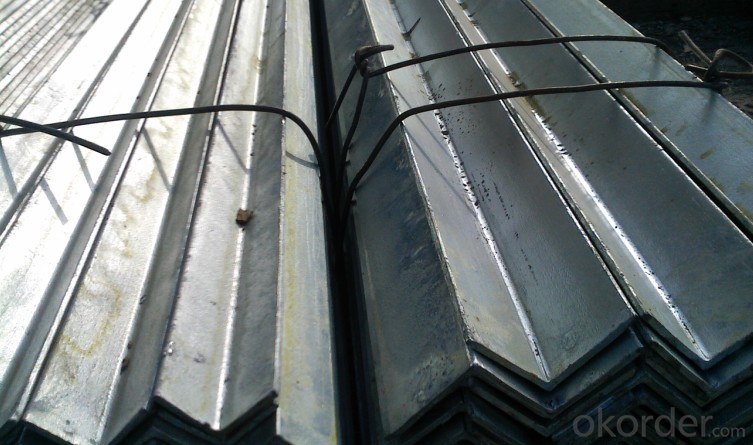
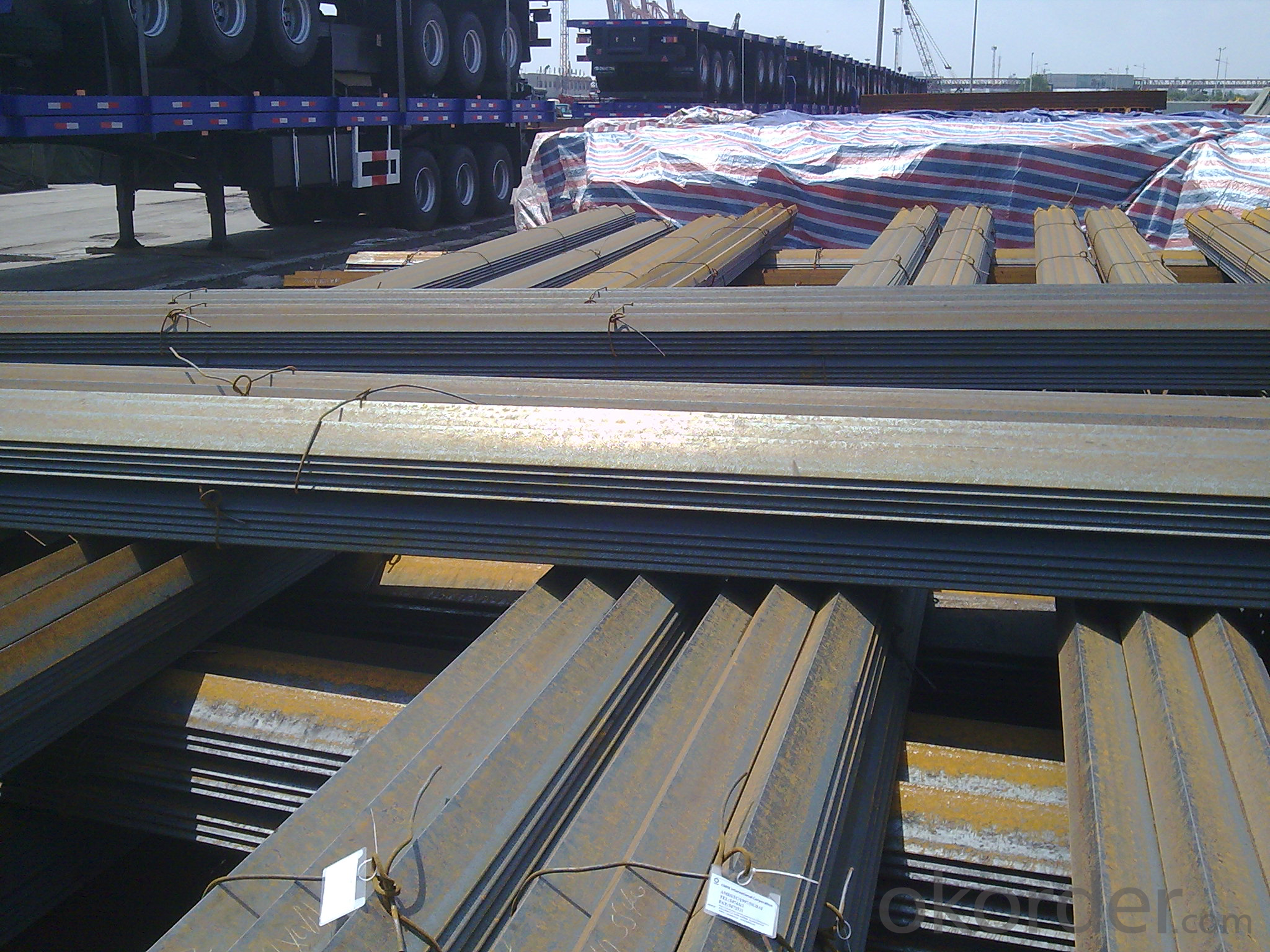
- Q: Are steel angles magnetic?
- Steel angles possess magnetic properties as they are made of steel, a ferromagnetic material. Ferromagnetic materials, like steel, can be magnetized and are drawn towards magnets. Due to the composition of steel, which includes iron and other elements, it exhibits a magnetic response. This characteristic finds practical applications in diverse fields, including construction, where steel angles are frequently employed to provide structural support.
- Q: How do you transport steel angles safely?
- Transporting steel angles safely requires proper planning and adherence to specific guidelines. Here are a few steps to ensure the safe transportation of steel angles: 1. Secure the steel angles: Start by ensuring that the steel angles are properly secured before transportation. This can be done by using straps or chains to hold them in place. Make sure the angles are tightly secured to prevent any movement or shifting during transit. 2. Use suitable transportation equipment: Select the appropriate transportation equipment based on the quantity and size of the steel angles. Flatbed trucks or trailers with secure tie-down points are often used to transport steel angles. If necessary, consider using specialized equipment such as cranes or forklifts to load and unload the angles safely. 3. Protect the steel angles: To prevent damage during transit, it's crucial to protect the steel angles from potential hazards. This can be achieved by using suitable packaging materials such as cardboard or wooden crates to cover the angles and provide additional support. Additionally, consider using protective padding or blankets to prevent scratches or dents. 4. Ensure weight distribution: Proper weight distribution is essential to maintain stability during transportation. Make sure the load is evenly distributed across the transportation equipment to prevent imbalance or tipping. If necessary, consult weight distribution guidelines or seek professional advice to ensure safe transportation. 5. Follow local regulations: Familiarize yourself with local transportation regulations and guidelines. Ensure compliance with any specific requirements related to securing the load, maximum weight limits, or permits required for oversized shipments. This will help ensure legal compliance and safe transportation. 6. Inspect and maintain the transportation equipment: Regularly inspect the transportation equipment for any signs of wear and tear. Check the condition of straps, chains, or tie-down points to ensure they are in good working order. Properly maintained equipment reduces the risk of accidents or incidents during transportation. 7. Plan the route and consider weather conditions: Before transporting steel angles, plan the route carefully, taking into account any potential obstacles or road conditions that may impact safety. Be aware of any height or weight restrictions on certain roads or bridges. Additionally, consider weather conditions such as heavy rain, snow, or high winds, and adjust the transportation plan accordingly. By following these steps and taking necessary precautions, you can transport steel angles safely, minimizing the risk of damage, accidents, or injuries. Always prioritize safety and ensure compliance with applicable regulations for a successful transportation process.
- Q: What are the different types of steel angles used in material handling systems?
- Material handling systems commonly utilize various types of steel angles for structural support and reinforcement. The following are some examples of the different steel angles used in these systems: 1. Equal Leg Angles: These angles possess equal sides and play a crucial role in providing structural support within material handling systems. Their application is typically seen in scenarios where the load is evenly distributed. 2. Unequal Leg Angles: These angles are characterized by unequal sides. They find utility in material handling systems where the load distribution is not uniform. By offering design flexibility, unequal leg angles enable the system to accommodate different load requirements. 3. L-Shaped Angles: L-shaped angles are frequently employed in material handling systems. They serve to form corners or connect various components together. These angles enhance the system's stability and provide reinforcement, particularly at joints and intersections. 4. Slotted Angles: Slotted angles are versatile steel angles that possess a series of holes along their length. These holes facilitate easy adjustment and customization of the material handling system. They are often utilized in the creation of shelving units, workbenches, and other storage solutions. 5. Perforated Angles: Similar to slotted angles, perforated angles feature a pattern of holes across their surface. These holes enhance ventilation and drainage within the material handling system. Common applications for perforated angles include conveyor systems and storage racks where airflow or liquid drainage is essential. 6. Stainless Steel Angles: Stainless steel angles offer high resistance to corrosion and are prevalent in material handling systems operating in harsh environments or requiring hygienic conditions. They excel in applications that prioritize cleanliness, durability, and rust resistance. These examples highlight just a few of the numerous steel angle types employed in material handling systems. The selection of the appropriate angle depends on specific system requirements such as load capacity, structural integrity, and environmental factors. Consulting a professional engineer or designer is crucial in determining the most suitable steel angle for a material handling system.
- Q: How do you protect steel angles during transportation?
- To ensure the safety and prevent damage of steel angles during transportation, there are several measures that can be taken. Firstly, it is crucial to package the steel angles securely in a manner that reduces movement and eliminates direct contact with other objects that could cause scratches or dents. This can be achieved by utilizing suitable packaging materials like protective films, foam padding, or cardboard sheets. Furthermore, proper stacking and arrangement of the angles in the transportation vehicle is essential to avoid shifting during transit. They should be placed on a stable and level surface, and if multiple layers are required, interlayer materials such as wooden boards can be utilized to provide stability and distribute the weight evenly. Considering the climate conditions during transportation is also vital. If the steel angles are being transported in an open vehicle, they must be adequately covered with waterproof tarpaulins to protect against rain, snow, or other weather elements. Even if the angles are being transported in a closed vehicle, it is still important to ensure proper ventilation to prevent condensation and the formation of rust. Lastly, careful handling and proper loading/unloading procedures are crucial to safeguard the steel angles from impacts and accidents. The use of appropriate lifting and handling equipment, such as cranes or forklifts, should be implemented to minimize any potential damage during these processes. By adhering to these protective measures, the steel angles can be safeguarded during transportation, ensuring they reach their destination in optimal condition, ready for use or further processing.
- Q: What are the limitations of using steel angles in certain applications?
- When considering the utilization of steel angles in specific applications, one must take into account several limitations. To begin with, steel angles may not be suitable for applications that necessitate high strength or load-bearing capacities. While steel angles are generally robust and long-lasting, they may not be capable of withstanding exceedingly heavy loads or forces. In such instances, alternative types of structural steel sections, such as I-beams or hollow sections, may be more appropriate. Additionally, steel angles may not be ideal for applications that require precise dimensions or tight tolerances. Due to the manufacturing process, steel angles can exhibit slight variations in size and shape, which may be unacceptable in certain applications. In these circumstances, it may be necessary to utilize custom-made or precision-machined steel components. Moreover, steel angles may possess limitations in terms of corrosion resistance. If the application involves exposure to harsh environments, such as marine or chemical settings, the steel angles may deteriorate over time. In such situations, materials with superior corrosion resistance, such as stainless steel or aluminum, may be more suitable. Lastly, steel angles may not deliver the desired aesthetic appearance in certain applications. Although steel angles are commonly employed in structural and industrial settings, they may not be visually appealing or compatible with architectural or decorative applications. In these cases, alternative materials or finishes may be preferred to achieve the desired aesthetics. In summary, while steel angles offer numerous advantages in terms of strength, versatility, and cost-effectiveness, they do have limitations in certain applications. It is crucial to thoroughly evaluate the specific requirements of the application and consider these limitations before deciding to utilize steel angles.
- Q: How do steel angles contribute to energy-efficient construction?
- Steel angles contribute to energy-efficient construction in several ways. Firstly, steel angles are commonly used as structural components in buildings, such as in the framing of walls, roofs, and floors. Their high strength-to-weight ratio allows for the creation of lighter and more efficient structures. This means that less steel is needed to support the building, reducing the overall weight and material usage, which in turn reduces the energy required for construction and transportation. Secondly, steel angles can be easily prefabricated off-site, allowing for faster construction times and reduced labor costs. This not only saves time and money but also minimizes energy consumption during the construction process. Moreover, steel is a highly durable and long-lasting material, which reduces the need for frequent maintenance and repairs. This durability translates into energy savings over the life cycle of the building, as less energy is required for ongoing maintenance and replacements. Additionally, steel angles can be recycled at the end of their life cycle, reducing the demand for virgin materials and minimizing the environmental impact of construction. The recycling process requires less energy compared to the production of new steel, resulting in energy savings and reduced greenhouse gas emissions. Lastly, steel angles can be integrated into energy-efficient building systems, such as insulation, HVAC ductwork, and renewable energy installations. The versatility of steel allows for the creation of systems that optimize energy performance, such as efficient heating and cooling systems or solar panel installations. In conclusion, steel angles contribute to energy-efficient construction by providing strength and stability while reducing material usage, enabling faster construction times, minimizing maintenance needs, facilitating recycling, and integrating with energy-efficient building systems.
- Q: How do steel angles contribute to the overall stability of a building frame?
- Steel angles contribute to the overall stability of a building frame by providing structural support and reinforcement. They are commonly used as braces and connections in building frames to increase their load-bearing capacity and resist forces such as wind, earthquakes, and heavy loads. The angles help distribute and transfer the loads throughout the structure, enhancing its stability and preventing deformation or collapse.
- Q: How do you calculate the buckling capacity of a steel angle?
- To calculate the buckling capacity of a steel angle, you need to consider several factors. Firstly, determine the effective length of the angle. This is the distance between points of rotation or points of restraint. Next, calculate the slenderness ratio, which is the effective length divided by the radius of gyration. The radius of gyration is a measure of how the steel angle's cross-sectional area is distributed around its centroid. Once you have the slenderness ratio, you can refer to design codes or standards, such as the American Institute of Steel Construction (AISC) Manual, to find the critical buckling stress or load for the given slenderness ratio. These codes provide tables or formulas to determine the critical buckling capacity based on the angle's dimensions and material properties. It is important to note that the buckling capacity of a steel angle depends on the boundary conditions, end fixity, and the method of buckling, whether it is flexural or torsional. Therefore, understanding the specific loading and boundary conditions is crucial in accurately calculating the buckling capacity.
- Q: Can steel angles be drilled or machined?
- Yes, steel angles can be drilled or machined. Steel angles are commonly used in construction and manufacturing industries due to their strength and durability. They can be easily drilled or machined to create holes or cut into specific shapes or sizes. However, it is important to use appropriate tools and techniques when working with steel angles as they are made of a hard material that requires high-speed drilling or machining equipment. Additionally, using lubricants or coolant during the drilling or machining process can help to reduce friction and heat buildup, ensuring a smooth and efficient operation.
- Q: What size does angle iron 125*10 mean?
- The width of the equal angles is 125mm and the thickness is 10mm
Send your message to us
High Quality Hot Rolled Steel Unequal Angle Equal Angle for Construction
- Loading Port:
- Tianjin
- Payment Terms:
- TT OR LC
- Min Order Qty:
- 25000 m.t.
- Supply Capability:
- 2000000 m.t./month
OKorder Service Pledge
OKorder Financial Service
Similar products
Hot products
Hot Searches
Related keywords
